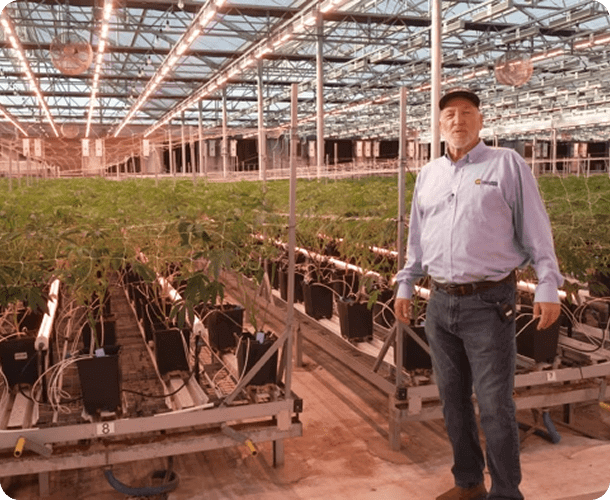A plant’s chemical composition affects everything from the taste to the color to the fragrance. Many growers wonder if there’s a way to manipulate the chemical composition of their own plants to customize their final yield. In recent years, with the increasing popularity of LED lights with variable spectrum control, there has been a lot of research about how light spectrums affect a plant’s chemical profile. Can you change the chemical profile of a plant by changing the light spectrum? The short answer is yes, absolutely, but there’s a lot we still need to learn.
We are just beginning to understand the relationship between light spectrum and chemical composition. Therefore, there’s no exact roadmap that will tell you precisely how light spectrums affect the biological activity in a plant. However, we do have some idea of how different spectrums interact with plants on a chemical basis. This has helped some growers figure out how to tweak settings to customize their yield.
How Does Light Spectrum Change the Chemical Profile of a Plant?
The knowledge that the light spectrum affects a plant’s chemical profile is nothing new. As early as the 18th century, scientists suspected that exposure to different light spectrums could change a plant’s composition given how light could decompose salt and bleach oils. It’s now well established that different light spectrums affect plants in different ways, and that varying degrees of light exposure have a huge impact on how a plant grows.
However, LED lights have only recently become popular on such a wide, commercial scale. Therefore, we’re still discovering ways they affect plant growth and chemical composition, and the implications their effects have on various aspects of plant life.
How does light spectrum change a plant’s chemical profile? Every plant has millions of photosynthetic receptors in each leaf, each with its own specialized pigments. These pigments all absorb specific light frequencies during photosynthesis. Different light spectrums trigger varying levels of photosynthetic activity, meaning plants will grow and develop differently depending on spectrum exposure.
Naturally, a plant’s chemical composition has a big impact on its appearance, taste, color, and so on. This is why many growers opt for LED lights with spectrum control. The more light spectrum available, the more you can fine-tune settings to get the yield you want.
How Do Plants Change Under Different Light Spectrums?
Plants change quite a bit under different spectrums, as different wavelengths interact with different pigments to trigger varying chemical reactions.
Here is a brief overview of how different lights affect a plant’s chemical profile:
Ultraviolet Light
Ultraviolet Light tends to affect a plant’s metabolic processes. It can enhance antioxidant activity and promote accumulation of phenolic compounds. In practical terms, this means UV light contributes to a plant’s colors, tastes, and fragrances.
Blue Light
Blue light affects chlorophyll formation as well as plant responses like curvature, elongation growth, and seedling growth regulation. Blue light encourages vegetative growth, primarily, and also encourages the production of pigments that enhance colors.
Green Light
While green light plays a smaller role in plant growth, it can be used to elicit specific responses in a plant like stomatal control, phototropism, and growth and environmental signaling. While it’s widely considered one of the least effective wavelengths for photosynthesis, some studies show it has better canopy penetration, allowing it to more efficiently reach lower leaves.
Red Light
Red light is vital for flowering and fruiting regulation as these wavelengths encourage stem growth and the production of flowers, fruit, and chlorophyll. Red light also triggers very strong photosynthetic action and can help induce flowering and regulates germination.
What Does This Mean For Me?
What does all this information mean on a practical level for the average grower? It’s complicated, primarily for two reasons.
First, again, there is still a lot we have to learn about how a plant’s chemical profile manifests when the plant is ready for harvest. Second, there is no one-size-fits-all spectrum mix. A lot depends on your personal goals as a grower. Every spectrum mix results in unique changes to your plants. Even with the same species of plant, different strains evolved under different environmental conditions so there is a wide variation in responses.
For example, UV supplementation for the last few weeks of the flower period can increase THC levels by up to 30%. If you want to maximize flower yield, running fairly high levels of red lights throughout the entire growth cycle can help there. Blue light can stimulate Terpene production, which leads to more fragrant plants, but tends to reduce yield.
As you can see, every spectrum has a unique effect on your flower. As of right now, there are no hard and fast rules regarding how light spectrum alters a plant’s chemical composition. In other words, there’s no special formula to follow to get the yield you want, and a lot comes down to doing rigorous research combined with some trial and error.
What we do know is that LED lighting is highly beneficial for growers looking to customize their yields. This is why LEDs are becoming increasingly more prevalent than MH and HPS bulbs. Our SolarXtreme series provides full-spectrum lamps, while our SolarSystem series provides variable spectrum control.
Conclusion
Is it entirely possible to change the chemical profile of a plant by changing the light spectrum. This is a big reason why variable spectrum LED lights are vital if you’re looking to cultivate a specific fragrance, potency, color, and so on.
The precise connection between light spectrum and chemical composition is complicated and not yet fully understood. Not only that, there’s no black-and-white chemical profile that will provide you blueprints for the exact yield you want.
However, LED grow lights do give you a lot more control over reaching your final goals than other lighting options. The ability to change light spectrums throughout the grow cycle will yield different results, and part of the fun of growing is experimenting with different techniques over time.
As always, we’re happy to help if you have any questions. Reach out here.





